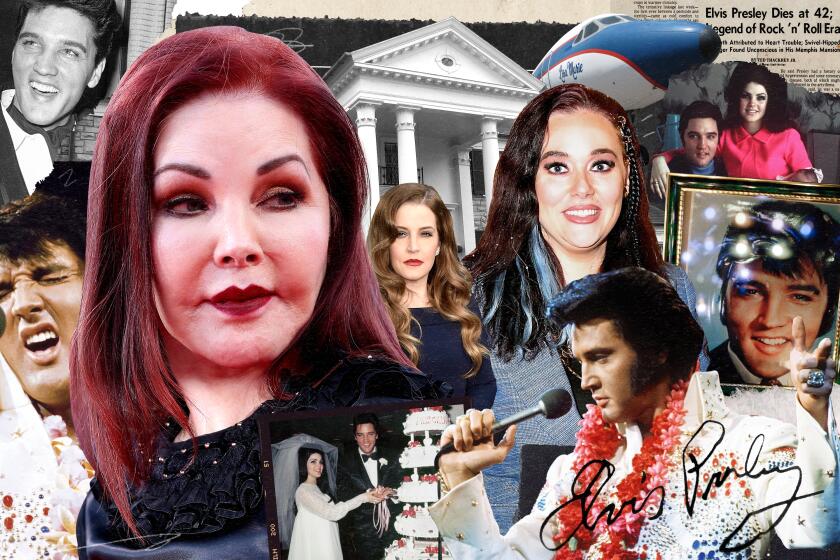KCET Profile on Ellington in a Class by Itself
- Share via
One of his several uniquenesses was that Duke Ellington was a suave, articulate and engaging public personality with an actor’s charisma.
That alone set him apart from the great majority of big band leaders who found expression only through their instruments and their orchestras and could hardly introduce a number. Jazz fans who can identify Count Basie’s piano after two or three beats would be hard put to recognize his voice.
But the Duke, who knew that the music spoke for itself, also knew that a little extra couldn’t hurt. He made “Love you madly” a kind of verbal trademark. And he also talked thoughtfully and well about the music and about the remarkable men and women he gathered around him to make it.
The spoken Duke is abundantly represented in a rich, revealing two-part, two-hour profile, “A Duke Named Ellington,” which begins Friday night at 9 on KCET and concludes July 29 at the same hour.
It is another in the excellent “American Masters” series, co-produced with the Council for Positive Images in Santa Monica. With all else “A Duke Called Ellington” (the title is the only faintly infelicitous item in the proceedings) is a triumph of film and tape research.
There are black-and-white excerpts from the early films, both features and shorts, that the band did in Hollywood, with Ellington at his suavest, an indubitable star in formal dress and no trace of racial stereotyping.
In a television interview, apparently from the ‘50s, the unseen questioner asks Ellington about his music in relation to “his people.” The Duke toys with the answer with a kind of amused irony, then says, “ the people--that’s the better word-- the people rather than my people, because the people are my people.”
But there is a sequence from “Black, Brown and Beige,” which he called “a tone parallel” to the history of blacks in America and which the band played at its first appearance at Carnegie Hall in 1943.
The show’s researchers found television footage from the BBC and from Danish and Swedish television, the latter including one of the sacred pieces from late in his career, this one performed at the Gustav Vasa church in Stockholm, with a fine singer named Alice Babs doing a wordless and soaring obbligato above Ellington’s piano. It is in the program’s second hour.
Terry Carter co-produced and directed the profile. Leonard (Skip) Malone co-produced and wrote it, with Carter himself doing the voice-over narration. The producers have generously and wisely offered spacious excerpts from the music, and what can you say but that it is achingly good.
Here is Paul Gonsalves playing the long, electrifying tenor solo on “Diminuendo and Crescendo in Blue” at the Newport Jazz Festival in 1956--an event that gave the band a new impetus.
Here is Harry Carney on “The Far East Suite,” soloing on the baritone sax (that lumbering elephant in most reed sections) and giving it the grace and fluency of a low clarinet.
Here is Russell Procope, doing “Mood Indigo” at two moments in time and, as one of the several alumni who are interviewed on the shows, remembering how it was. They did “Mood Indigo” at every performance. No matter, he says; it was different every time. When you got on the stand and started playing, he says, nothing else mattered--not the fatigue, not the long absences from home, nothing, only the music.
Watching is not without melancholy. The Duke is gone and so are many of those matchless sidemen, including the impassive Johnny Hodges and his far from impassive alto. Other faces, not from the band, include pianists Teddy Wilson and Willie the Lion Smith, honoring Ellington the pianist.
The programs remind us that in fact Ellington was a very, very good pianist, who could match Willie the Lion stride for stride or play, as he often did, with the spiky, angular ultramodern percussiveness you associate with Thelonious Monk.
But he was at heart a colorist with spiritual links with Debussy and Ravel. The excerpts in the program’s second hour include a long Ellington solo on “Lotus Blossom,” a Billy Strayhorn composition the Duke says was perhaps his favorite.
Less obviously, the interviews done for the documentary point up that Ellington was a shrewd enough businessman to keep the band together and solvent for an unprecedented 47 years before he died.
He was also, clearly, a practicing psychologist who kept his often-misbehaving men in line, partly by holding the reins very loosely, partly by creating a place like no other for them to work. If you weren’t going to play for Duke, one of his men says, you might as well quit playing altogether.
Ellington turned his hand to everything, including a ballet for Alvin Ailey and American Ballet Theatre. (The second hour has glimpses of “The River” and of “Night Creature,” which Ailey based on an Ellington piece.)
There are eloquent assessments by several voices--among them Clark Terry, Herbie Hancock and Times jazz critic Leonard Feather--about the unique Ellington legacy and that long creative road from the Cotton Club in Harlem to a church in Sweden.
Terry Carter is now producing a series of 15 portraits called “Jazzgreats,” to include Chet Baker and Dexter Gordon. On the evidence of this one, they’ll be worth waiting for.
More to Read
The biggest entertainment stories
Get our big stories about Hollywood, film, television, music, arts, culture and more right in your inbox as soon as they publish.
You may occasionally receive promotional content from the Los Angeles Times.










